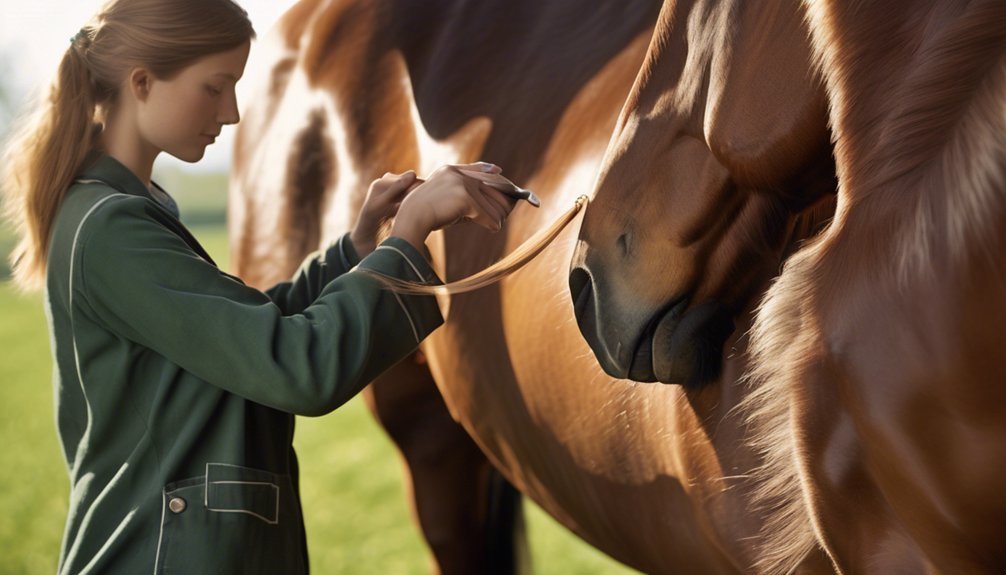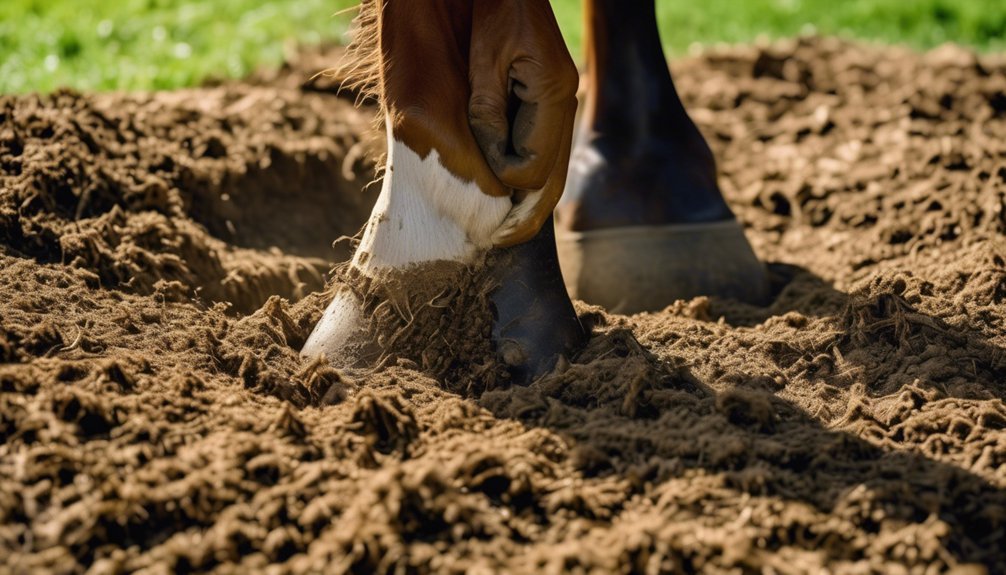
Grooming is vital for maintaining hygiene, monitoring health, and strengthening the bond with your horse. By regularly inspecting the coat, skin, and overall condition, you can catch potential health issues early. Observing changes in coat quality, skin abnormalities, or signs of parasites can provide critical insights. Understanding the essential techniques and tools for effective grooming will enhance your ability to assess your horse's well-being, ensuring you're always one step ahead in their care.
Key Takeaways
- Regular grooming helps maintain a clean coat, allowing for easier observation of skin quality and potential health issues.
- Use grooming tools like curry combs and brushes to stimulate blood circulation and distribute natural oils, promoting skin health.
- During grooming, check for lumps, bumps, or irritations on the skin that may indicate infections or allergies.
- Inspect hooves carefully with a hoof pick to ensure they are clean and free from debris, preventing potential lameness.
- Monitor changes in coat texture, shine, and overall appearance to detect early signs of health concerns or discomfort.
The Importance of Regular Grooming

While you may think grooming is just about appearance, regular grooming is crucial for your horse's overall health and well-being. This routine not only helps maintain a clean coat but also promotes skin health by stimulating blood circulation and distributing natural oils.
You'll notice grooming benefits extend beyond hygiene; it's an excellent opportunity to check for injuries, irritations, or signs of illness that might otherwise go unnoticed. Moreover, grooming fosters a deeper bond between you and your horse, enhancing trust and communication.
As you work together, you'll both benefit from this intimate time, reinforcing your connection. By prioritizing regular grooming, you ensure your horse remains healthy, happy, and ready for the adventures ahead.
Essential Grooming Tools and Supplies
Having the right grooming tools is essential for maintaining your horse's health and appearance. Quality grooming brushes and equine shampoos play a crucial role in this process.
Here are some must-have items for your grooming kit:
- Curry Comb: Perfect for loosening dirt and hair from the coat.
- Soft-Bristle Brush: Ideal for removing dust and giving your horse a shiny finish.
- Equine Shampoo: Specifically formulated to clean and nourish your horse's skin and coat.
Techniques for Effective Grooming

Effective grooming goes beyond simply brushing your horse's coat; it involves a systematic approach to ensure both cleanliness and health.
Start with a curry comb to loosen dirt and debris, using circular motions to stimulate the skin and promote circulation. Follow up with a stiff brush to remove the loosened particles, focusing on the neck, back, and hindquarters.
For sensitive areas, like the face and legs, use a softer brush for effective brushing without causing discomfort.
Don't forget to check hooves; use a hoof pick to remove stones and dirt.
Regularly incorporating these grooming techniques not only keeps your horse clean but also allows you to monitor their overall condition, enhancing your bond and ensuring their well-being.
Observing Your Horse's Skin Health
As you groom your horse, it's essential to observe their skin health closely, since any changes can indicate underlying issues.
Pay attention to the following aspects to ensure your horse's skin remains healthy:
- Coat quality: A shiny, smooth coat reflects good health, while dullness or dryness may signal skin conditions.
- Lumps or bumps: Feel for any unusual growths, as these can indicate infections or allergies.
- Irritation or redness: Monitor for any signs of inflammation, which could suggest skin conditions needing veterinary attention.
Regularly assessing these factors helps you catch potential health issues early, ensuring your horse stays comfortable and happy.
Checking for Signs of Parasites

While grooming, it's crucial to check for signs of parasites, as these pests can significantly impact your horse's health and comfort.
During your grooming sessions, pay attention to areas like the mane, tail, and underbelly, where parasites often hide. Look for excessive itching, hair loss, or skin irritations—these can indicate infestations.
Regular grooming increases your chances of catching these signs early, so maintain a consistent grooming frequency. Incorporate parasite prevention measures, such as deworming schedules and proper pasture management, to protect your horse from these threats.
By being vigilant during grooming, you help ensure your horse remains healthy and comfortable, allowing you both to enjoy your time together.
Monitoring Weight and Body Condition
Monitoring your horse's weight and body condition is essential for maintaining optimal health. Regular weight assessment and body scoring can help you identify potential issues early.
Use grooming sessions as an opportunity to evaluate your horse's physique.
- Feel the ribs and spine; they should be discernible but not prominent.
- Observe the overall shape; a well-conditioned horse has a smooth, rounded appearance.
- Check for fat deposits around the neck, withers, and tailhead.
Examining Hoof Health During Grooming

Grooming provides an excellent opportunity to assess your horse's hoof health, a crucial aspect of overall equine wellness. During grooming, take a moment to examine the hoof structure closely.
Check for cracks, chips, or any abnormalities that might indicate underlying problems. Pay attention to the frog, sole, and hoof wall; healthy hooves should feel firm and resilient. Ensure there's no excessive heat or swelling, which may signal infection or injury.
Regular hoof care, including cleaning and picking out debris, helps maintain good hygiene, preventing issues like thrush. By integrating hoof assessments into your grooming routine, you foster a deeper connection with your horse and contribute to their long-term health and performance.
Identifying Behavioral Changes
Observing your horse's behavior during grooming can reveal important insights into their overall health. Pay close attention to any behavioral cues that might indicate stress or discomfort. Subtle changes can signal underlying issues.
- Frequent tail swishing or ear pinning may indicate irritation.
- A tense body posture or reluctance to stand still can be stress indicators.
- Changes in their usual grooming response, like flinching or moving away, could suggest pain.
Establishing a Grooming Routine

A consistent grooming routine is essential for maintaining your horse's health and well-being. Establish a grooming frequency that suits your schedule, aiming for at least three to four times a week. This not only helps you bond with your horse but also allows you to monitor their coat, skin, and overall condition.
Each grooming session should include brushing, hoof care, and checking for any abnormalities. The grooming benefits extend beyond aesthetics; it promotes circulation, reduces stress, and enhances your horse's comfort.
As you develop this routine, pay close attention to changes in your horse's behavior or physical condition, as they can provide valuable insights into their health. Regular grooming is a vital aspect of horse care you can't afford to overlook.
When to Consult a Veterinarian
Regular grooming sessions provide an opportunity to spot potential health issues early on.
It's crucial to recognize symptoms that may indicate a need for professional care. Here are some signs that warrant a consultation with your veterinarian:
- Unexplained weight loss or gain
- Persistent lameness or difficulty moving
- Changes in appetite or behavior
Timely intervention through symptom recognition can make a significant difference in your horse's health.
If you notice any of these signs, don't hesitate to reach out to a vet. Remember, your horse relies on you to notice when something's off, and addressing issues early can prevent more serious complications.
Keeping an open line of communication with your veterinarian ensures your horse's well-being is always prioritized.
Frequently Asked Questions
How Often Should I Groom My Horse for Optimal Health Monitoring?
You should groom your horse daily for optimal health monitoring. Establishing a consistent grooming schedule not only keeps your horse clean, but also allows you to spot any changes or issues early on.
Can Grooming Help Detect Internal Health Issues in Horses?
Yes, grooming can reveal health indicators like swelling, sensitivity, or changes in coat condition. By observing these grooming benefits, you're better equipped to notice potential internal issues early, ensuring your horse receives timely care.
What Signs of Stress Should I Look for During Grooming?
During grooming, watch for stress indicators like pinned ears, tail swishing, or tense muscles. Notice any grooming reactions: flinching, excessive yawning, or shifting weight. These signs can reveal your horse's emotional state and overall well-being.
How Does Seasonal Change Affect Grooming Practices?
Seasonal changes significantly impact grooming practices. As your horse's coat changes, you'll need to adjust your grooming routine. In spring, for instance, increased shedding requires more frequent brushing to maintain a healthy coat and skin.
Are There Specific Grooming Techniques for Older Horses?
For senior grooming, focus on gentle brushing to avoid discomfort. Use soft tools to ease joint care, paying attention to sensitive areas. Regularly check for any changes in skin or coat condition during your grooming sessions.
Conclusion
In conclusion, regular grooming is your horse's first line of defense against health issues, acting as a mirror reflecting their overall well-being. By diligently observing skin, coat, and hooves, you can catch potential problems early. Establishing a consistent grooming routine not only enhances hygiene but also strengthens your bond with your horse. Remember, when you notice something off, don't hesitate to consult a veterinarian—after all, a healthy horse is a happy horse.





